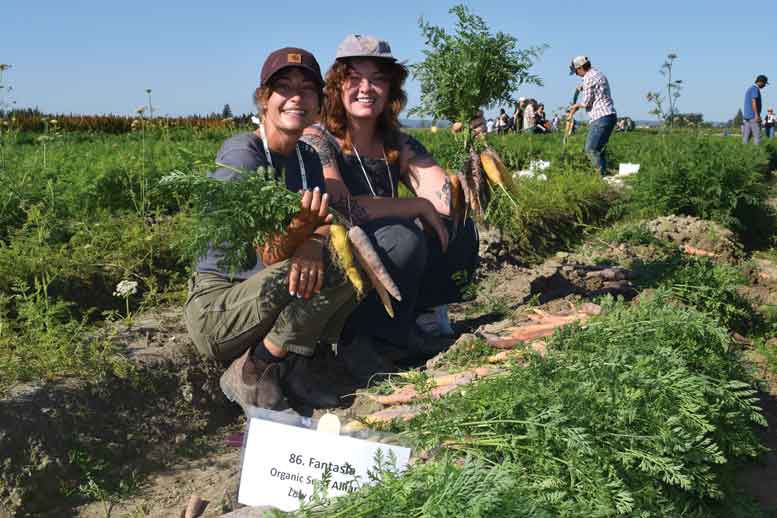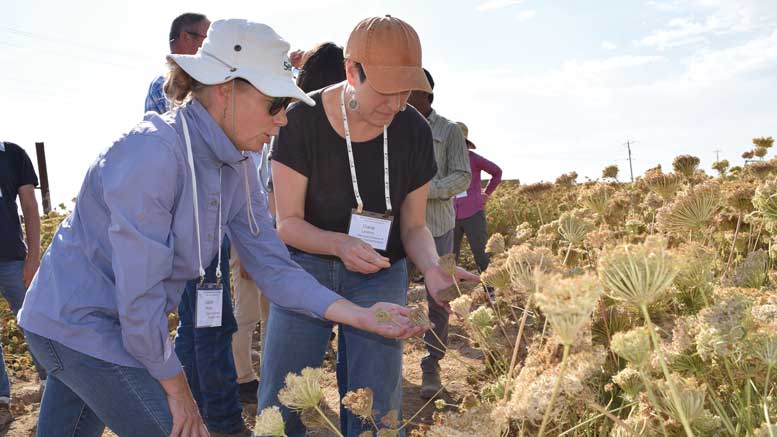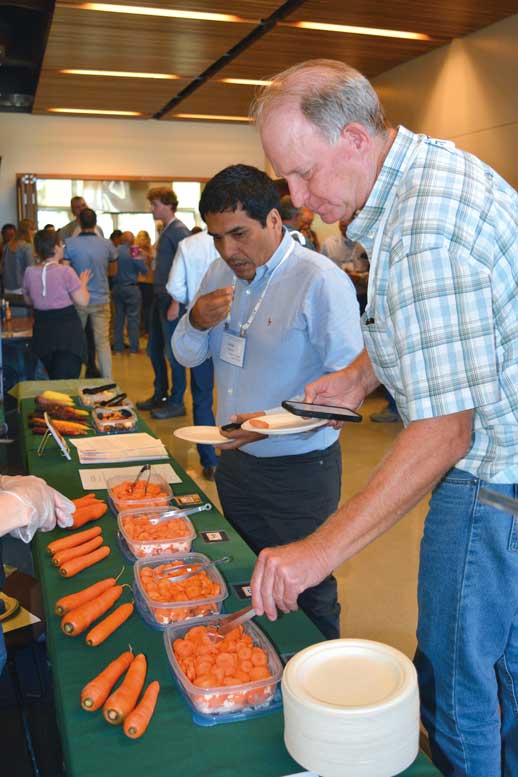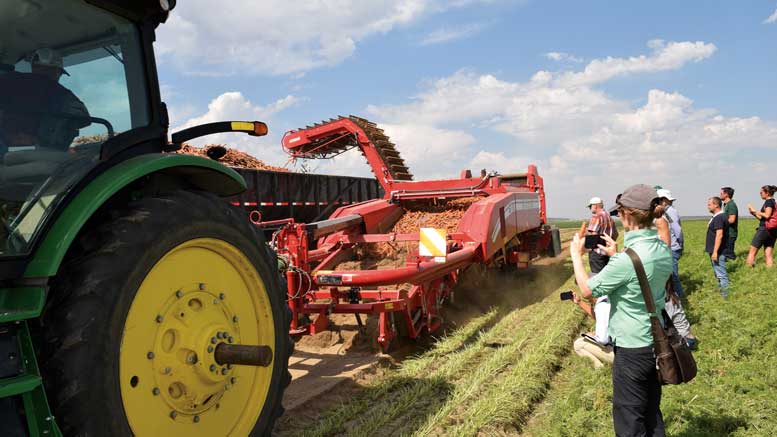|
Click to listen to this article
|
Story and photos by Denise Keller, Editor
After a two-year postponement, the 40th International Carrot Conference gave nearly 100 attendees from nine countries a look at the latest research and issues impacting the carrot industry.
The conference, held Aug. 29-30 in Mount Vernon, Washington, hosted university researchers and grad students, as well as seed company reps, breeders and a handful of growers. Attendance was lower than organizers had hoped, with the smaller turnout attributed to lingering concerns of international travel in the COVID era, as well as the meeting location. Participants of the 2018 International Carrot Conference, held in Wisconsin, voted to have the 2020 conference (which was rescheduled for 2022) in Western Washington despite the absence of any major carrot production in the area. This likely limited grower attendance, said Lindsey du Toit, conference organizing committee chair and Washington State University (WSU) vegetable seed pathologist.
For those who made the trip – with attendees hailing from the U.S., Canada, Brazil, Peru, France, the Netherlands, Italy, New Zealand and Japan – day one provided an overview of research being done on carrots in the U.S. Carrot breeders shared what traits they are selecting for, reporting on progress in breeding for resistance to nematodes and diseases such as cavity spot and bacterial leaf blight. They also discussed efforts to breed for traits such as fast-growing tops so carrots can better compete with weeds, especially important in organic production.

Conference Keynote
Roger Freeman, a carrot breeder with Nunhems/BASF, added to the conference with the keynote address, sharing his experiences, thoughts and observations from 40 years as a commercial carrot breeder.
To illustrate the length of his career, he reminded his audience how much technology has progressed over the course of the last four decades, mentioning the replacement of pay phones with smart phones and the transition from paper to digital data collection and storage.
Looking back on his career, Freeman first experienced carrot breeding in 1976 at Texas A&M University and then later completed his Ph.D. work on carrots at the USDA/University of Wisconsin before starting his career as a commercial carrot breeder in 1982 in Brooks, Oregon.
In his presentation, Freeman covered the history of commercial carrot production in the U.S., starting in the 1940s. This included the transition from open-pollinated varieties to hybrids, and the shift of production concentration from the eastern U.S. into California as the utilization of ice and refrigerated transport allowed for the availability of fresh year-round supply. Speaking to more recent changes, Freeman detailed the development of two new market segments of cut-and-peel snacking carrots and novel colored carrots. During these years, a very significant consolidation took place, through acquisitions, into much larger growers, retailers and global seed suppliers, Freeman recalled. He also spoke about the application of new digital and genetic tools, and the precision and efficiency improvements in farming and seeds.
While sharing experiences and perspectives related to commercial carrot breeding and production during his 40 years in the industry, Freeman also discussed the careers and contributions of three late university carrot researchers. This included the discovery and implementation of cytoplasmic male sterility into orange carrots, followed by the release to seed companies of an inbred line possessing this trait in 1963 by Dr. C.E. Peterson at Michigan State University. It was a very significant discovery and release and now the basis of almost all carrot hybrids used in North America and possibly a majority throughout the world, according to Freeman.

Skagit Valley Tour
The conference moved from the classroom to the field for day two, beginning with the viewing of a cultivar demonstration at the WSU Northwestern Washington Research and Extension Center. Planted specifically for the conference, the trial consisted of 183 carrot cultivars including commercially available varieties and experimental breeding lines. Unfortunately, the soil at the Mount Vernon research center is a heavy clay soil that is not ideal for carrot production. As a result, some roots were cracked and lacked uniformity in shape.
“Most people were very gracious about it. Some of the breeders said ‘We don’t mind this because it gives us a chance to see how well our varieties do under these kinds of conditions,’” du Toit said. “They consider it a purgatory trial. They put the varieties through purgatory and see how well they perform.”
A stop at Ralph’s Greenhouse demonstrated the difference in soil types. Conference organizers had planted a 58-variety organic carrot cultivar trial at the farm, located in the fertile floodplain of the Skagit River. Grown in sandier soil, the roots looked good.
The afternoon provided a broader look at agriculture in northwestern Washington. Agriculture is the top industry in Skagit County, with more than 90 different crops grown in the county. A visit to Washington Bulb Company provided a glimpse of the Skagit Valley’s flower bulb business. More tulip and daffodil bulbs are produced in Skagit County than in any other county in the U.S. The day wrapped up with a tour of Skagit Valley Farm, where visitors made quick stops in fields of Brussels sprouts, broccoli and specialty potatoes.

Central Washington Tour
Conference attendees were invited to stay a third day to tour the carrot industry in Central Washington. About 25 people took advantage of the opportunity to see the scale of production in the semi-arid growing region.
The tour started at Precision Seed Company near Ephrata. Although the group’s late-August visit came at the end of the carrot seed production cycle, they gained understanding of what it takes to produce carrot seed.
This was followed by a stop at WSU’s bee research facility in Othello, where the group heard a presentation on research related to pollinators.
The tour concluded at Klaustermeyer Farms in Basin City. Harvest was underway, and the grower’s novel method of topping carrots before pulling them from the ground intrigued the group and was an example of the insight participants – from students to breeders – took home with them.
“When you understand the connection of what you do to the actual producer’s situation, it puts the context in place for your work, whether you’re a researcher like me or a breeder,” du Toit says. “You have a more thorough understanding of how carrots are grown, how they’re used and what kind of traits might be important from a breeding perspective.”
Providing learning opportunities through this conference depends on a team effort among researchers, universities, local seed companies and growers, du Toit said, adding that this is what makes the meeting most enjoyable for her.
“It’s that sense of community that everyone is in this together to help support the ability to grow good carrots and a healthy supply of carrots,” du Toit said. “This conference is important for bringing people together to share, to understand better and to move forward as a whole community. That’s why we keep going and why we keep doing this work.”
The 41st International Carrot Conference is planned for spring 2024 in North Carolina.

